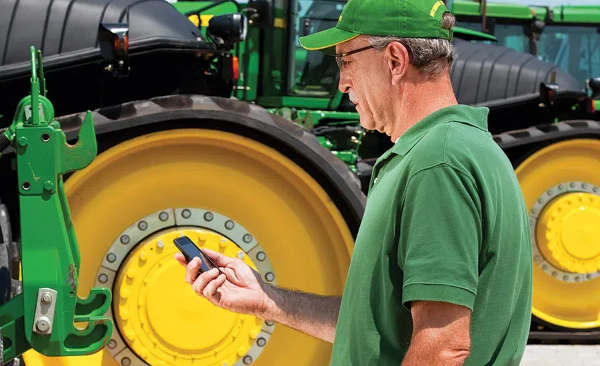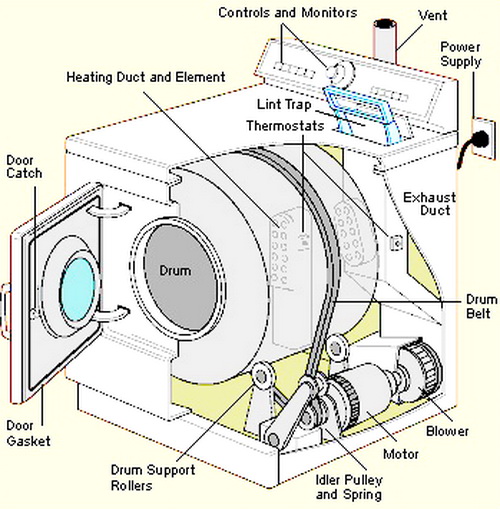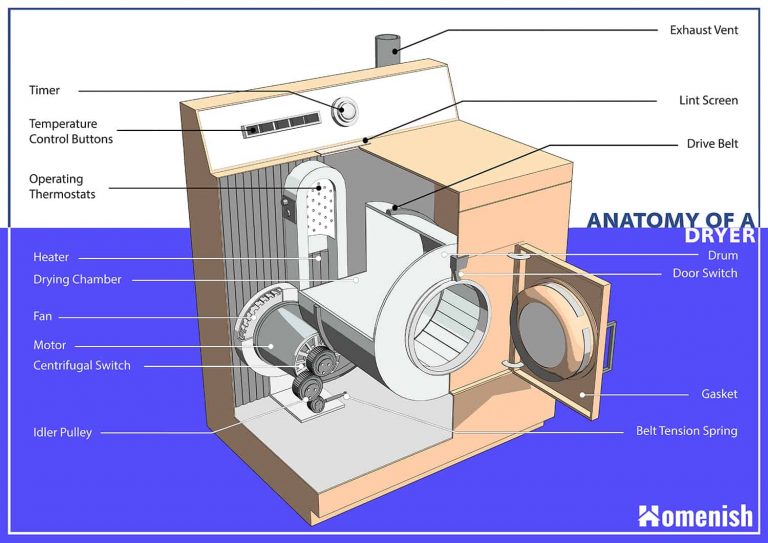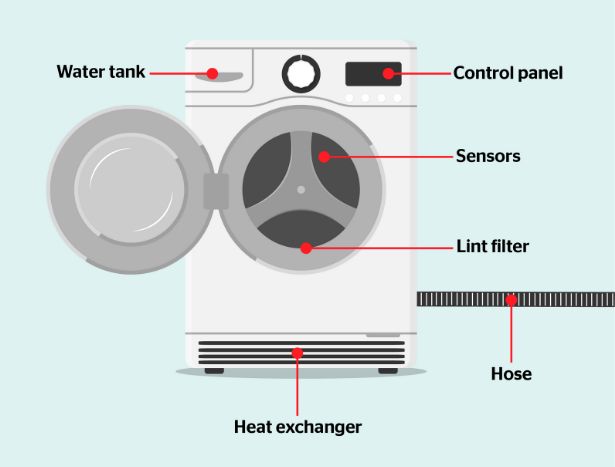
Content Menu
● Introduction
● The Basic Principle: Heat, Air, and Motion
● Key Components of a Dryer
>> 1. Drum
>> 2. Heating Element
>> 3. Gas Burner (for Gas Dryers)
>> 4. Blower or Fan
>> 5. Thermostat and Temperature Control
>> 6. Timer and Control Panel
>> 7. Lint Filter
● How Does a Dryer Work: Step-by-Step Process
>> Step 1: Air Intake
>> Step 2: Heating the Air
>> Step 3: Hot Air Circulation
>> Step 4: Moisture Extraction
>> Step 5: Moist Air Removal
>> Step 6: Exhaust
● Types of Dryers: Electric vs. Gas
>> Electric Dryers
>> Gas Dryers
● Energy Efficiency and Advanced Features
>> Heat Pump Dryers
● Maintenance and Troubleshooting
● The Future of Clothes Drying Technology
● Conclusion
● Frequently Asked Questions
>> Q1: How often should I clean my dryer's lint filter?
>> Q2: Are gas dryers more efficient than electric dryers?
>> Q3: Why are my clothes still damp after a full drying cycle?
>> Q4: How can I make my dryer more energy-efficient?
>> Q5: Is it safe to leave the dryer running when I'm not at home?
Introduction
Clothes dryers have become an indispensable appliance in many households, offering convenience and time-saving benefits. But have you ever wondered about the intricate mechanisms that make these machines work? In this comprehensive guide, we'll delve into the fascinating world of clothes dryers, exploring their components, functions, and the science behind their operation.
The Basic Principle: Heat, Air, and Motion
At its core, a clothes dryer operates on a simple principle: combining heat, airflow, and motion to remove moisture from wet clothes. This process involves several key components working in harmony to achieve efficient drying.

Key Components of a Dryer
1. Drum
The drum is the heart of the dryer, where clothes are tumbled. It's typically made of stainless steel or coated metal and features small holes or perforations that allow hot air to circulate through the clothes.
2. Heating Element
In electric dryers, a heating element is responsible for generating the hot air needed for drying. This element consists of metal coils that heat up when electricity passes through them.
3. Gas Burner (for Gas Dryers)
Gas dryers use a gas burner instead of an electric heating element. The burner ignites natural gas or propane to produce heat.
4. Blower or Fan
The blower or fan is crucial for circulating hot air through the drum and expelling moist air from the dryer.
5. Thermostat and Temperature Control
These components regulate the temperature inside the dryer, ensuring clothes are dried efficiently without overheating.
6. Timer and Control Panel
The timer and control panel allow users to select different drying cycles and settings based on fabric type and moisture level.
7. Lint Filter
The lint filter captures loose fibers and debris from clothes, preventing them from clogging the exhaust system.
How Does a Dryer Work: Step-by-Step Process
Step 1: Air Intake
The process begins with the dryer drawing in air from its surroundings. This air is typically at room temperature.
Step 2: Heating the Air
The intake air passes over the heating element (in electric dryers) or through the gas burner (in gas dryers), where it's heated to the appropriate temperature based on the selected drying cycle.
Step 3: Hot Air Circulation
The blower or fan system forces the heated air into the drum, where it comes into contact with the wet clothes.
Step 4: Moisture Extraction
As the drum rotates, the clothes tumble, exposing all surfaces to the hot air. This motion, combined with the heat, causes the water in the clothes to evaporate.
Step 5: Moist Air Removal
The now-moist air is drawn out of the drum by the blower, passing through the lint filter to remove any loose fibers.
Step 6: Exhaust
Finally, the moist air is expelled from the dryer through the exhaust vent, typically located at the back of the machine.

Types of Dryers: Electric vs. Gas
While the basic drying principle remains the same, there are two main types of dryers based on their heat source: electric and gas.
Electric Dryers
Electric dryers are the most common type found in households. They use electricity to power both the motor that turns the drum and the heating element. The heating element, typically made of nichrome wire, heats up as electricity passes through it, warming the air that circulates through the dryer.
Advantages of electric dryers include:
- Easier installation (only requires a 240V outlet)
- Lower initial cost
- No need for gas lines
Gas Dryers
Gas dryers use natural gas or propane as their heat source. They still require electricity to power the drum motor and controls, but the heating is done by burning gas. A gas valve releases gas into a burner, which is then ignited by an electric ignition system.
Advantages of gas dryers include:
- Lower operating costs in most areas
- Faster drying times
- More environmentally friendly in some regions
Energy Efficiency and Advanced Features
Modern dryers have come a long way in terms of energy efficiency and advanced features. Many now incorporate sensors that can detect the moisture level in clothes and automatically adjust drying time and temperature, preventing over-drying and saving energy.
Heat Pump Dryers
One of the most significant advancements in dryer technology is the heat pump dryer. These dryers use a heat pump to recirculate hot air, making them incredibly energy-efficient.
Heat pump dryers work by:
1. Extracting warm, moist air from the drum
2. Passing this air over a cold evaporator coil, which condenses the moisture
3. Reheating the now-dry air using a condenser
4. Circulating the reheated air back into the drum
This closed-loop system uses significantly less energy than traditional vented dryers.
Maintenance and Troubleshooting
To ensure your dryer operates efficiently and safely, regular maintenance is crucial. Here are some key maintenance tasks:
1. Clean the lint filter after every use
2. Check and clean the exhaust vent periodically
3. Inspect the drum seal and replace if worn
4. Clean the moisture sensors
5. Check the drive belt for wear and tear
Common issues with dryers include:
- Not heating properly
- Making unusual noises
- Taking too long to dry clothes
- Stopping mid-cycle
Many of these issues can be resolved through simple troubleshooting or by calling a professional repair service.
The Future of Clothes Drying Technology
As technology advances, we can expect to see even more innovative features in clothes dryers. Some potential developments include:
- AI-powered drying cycles that learn from your laundry habits
- Integration with smart home systems for remote operation and monitoring
- More eco-friendly designs that use alternative heat sources or drying methods
Conclusion
Understanding how a clothes dryer works can help you use it more effectively and troubleshoot issues when they arise. From the basic principles of heat and airflow to the advanced features of modern machines, clothes dryers are a testament to human ingenuity in simplifying everyday tasks.

Frequently Asked Questions
Q1: How often should I clean my dryer's lint filter?
A1: You should clean your dryer's lint filter after every use. This simple habit ensures optimal airflow, improves drying efficiency, and reduces the risk of fire hazards.
Q2: Are gas dryers more efficient than electric dryers?
A2: Generally, gas dryers are more energy-efficient and have lower operating costs than electric dryers. However, the initial cost of a gas dryer is usually higher, and installation may be more complex if you don't already have a gas line.
Q3: Why are my clothes still damp after a full drying cycle?
A3: Several factors could cause this issue:
- Overloading the dryer
- Clogged lint filter or exhaust vent
- Malfunctioning heating element
- Incorrect cycle selection for the type of fabric
Check these potential causes and clean or repair as necessary.
Q4: How can I make my dryer more energy-efficient?
A4: To improve your dryer's energy efficiency:
- Clean the lint filter and exhaust vent regularly
- Use the moisture sensor settings if available
- Dry full loads, but don't overload
- Consider upgrading to a heat pump dryer for maximum efficiency
Q5: Is it safe to leave the dryer running when I'm not at home?
A5: It's generally not recommended to leave your dryer running unattended. While modern dryers have safety features, there's always a small risk of fire, especially if the lint filter or exhaust vent is clogged. It's best to be present when your dryer is in operation.












